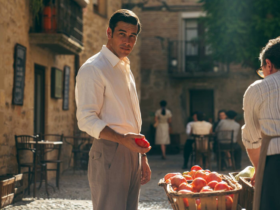Buying wallpaper for the kitchen, each of us relies on our own taste. But when choosing the material, it is necessary to take into account such aspects as physical properties and color scheme.
What characteristics should kitchen wallpaper have
Video — gluing vinyl wallpaper
The main characteristics of the material that is used for wall decoration in the kitchen allow the wallpaper to withstand many tests.
Density. The denser the material from which the wallpaper is made, the longer they will last. In addition, a lot depends on this characteristic: low -quality thin paper is usually porous, and micro -generals are quickly filled with dirt.
Moisture resistance. The walls of the kitchen are often undergoing wet cleaning, therefore, the material should be moisture resistant.
Good vapor permeability. The microclimate of the room depends on this characteristic, and condensate does not accumulate.
Light resistance. If the wallpaper is unstable to the sun’s rays, repair work whether you want this or not, they will become your hobby.
Fire resistance. Cooking is always associated with the danger of fire, so the shell of kitchen walls should have a high degree of resistance to fire.
Wallpaper for the kitchen — washing, vinyl, liquid ..
The video presents tips to remove old vinyl wallpaper
Focusing on the above requirements, we will single out the most suitable types of wall coatings, their pros and cons:
Paper washing. The main plus of this type is the price. They are easy to clean with a wet sponge. Alas, there are also disadvantages: low wear resistance, which significantly reduces the service life.
Vinyl. Thanks to vinyl, they have good moisture resistance, and the rough surface will hide the uneven walls. This type of wallpaper is porous, which reduces its wear resistance. Therefore, the main attention should be paid to density.
Liquid wallpaper. The best option for «lazy». Easily applied, do not require the special skills necessary for pasting walls. High wear resistance can be achieved by covering them with varnish.
For painting. Are distinguished by durability and a high degree of wear resistance. Withstand up to 15 stains. This is a plus for lovers of frequent interior change. Minus — high price.
Fiberglass. In addition to wet cleaning, they can easily survive cleaning with a brush. This type of coating can be repainted several times.
Self -adhesive. Correspond to all the necessary characteristics, applying to the walls does not require special knowledge and skills. True, only a perfectly smooth surface can be glued with this material.
Attention! Cotton, natural bamboo, linen and silk, veneer wallpaper — not suitable for kitchen rooms. Such a coating, of course, has a number of advantages: naturalness, environmental friendliness, presentable view. However, they quickly accumulate dirt and absorb smells, and with frequent washing they lose their attractiveness.
Appetizing atmosphere — what color should be wallpaper in the kitchen
Using the color, you can visually hide these or other defects of the room. In other words, when choosing paper clothes for walls, you should think about visual correction and psychological background.
Visual correction with color. Carefully analyze the main characteristics of the room: area, height, illumination. Based on these data, you can determine the color and texture that are most suitable in your case:
The area of the room is adjusted by tone. Light walls visually increase the room, and dark tones, respectively, reduce.
The height of the ceilings can be edited by the pattern. Horizontal lines will bring the ceiling, vertical lines — stretch the walls up.
Lighting directly depends on the shades. The more warm color, the brighter your kitchen. If the room is on the sunny side, you should think about cold colors.
The psychological background is originally set by color. What color is the most acceptable material in order to maximize the appetite?
Red. Causes a brutal appetite, but, being the color of passion, enhances aggression.
Orange. Acts life -affirming, fills with positive and optimism.
Turquoise. Relieves tension and fatigue, calms, relaxes, harmonizes thoughts and actions.
Green and blue. These two colors are most suitable for concentrated work. On the one hand, they relax, on the other, they activate brain activity and help concentration of attention. These colors will turn funny feast into a business buffet.
White. This is a neutral color, harmoniously combined with any shades and interspersed of bright tones. In addition, it reduces the perception of smells. But, staining the walls into white without dilution with other colors, you run the risk of turning the kitchen into a sterile hospital room.
Gray in combination with pink, as well as purple colors are absolutely contraindicated for kitchen rooms. So, the gray-pink background is able to cause apathy and disgust, and purple depresses and reduces appetite.
According to psychologists, orange and turquoise are considered the most delicious colors. The shade of semiprecious «stone of happiness» causes a feeling of peace, and peach tones restore nervous costs and contribute to digestion.
Glue wallpaper in the kitchen
Playing the kitchen space with wallpaper is no different from work in the remaining rooms. First of all, it is necessary to remove the old coating. If necessary, plastered the walls and cover them with a primer. Even if you chose washing wallpaper, the walls will breathe. And since we are talking about the kitchen, it is worth paying special attention to the primer.
When the walls are prepared, you can proceed to glue. The most difficult thing is to glue the first strip. First measure the height of the wall and add a couple of centimeters to it — this is the length of the first wallpaper cut. Having retreated a little from the place to which this strip will stick, draw a vertical on the wall with a plumb line. Drawn vertical will serve as a guideline for the first canvas.
Cut the required strip, lubricate with glue and fold the canvas for impregnation. Then apply glue to the wall, unfold the “wallpaper” and glue. Smooth the strip of the strip from the center to the edges with a rubber spatula, thereby expelling air bubbles from under the paper. We glue the next cut in the same way, using the already glued stripes as a vertical. More detailed instructions on how to glue wallpaper is placed on our resource.
May your cuisine become a place of fun smiles, festive mood and delicious pastime!













Оставить коммент.